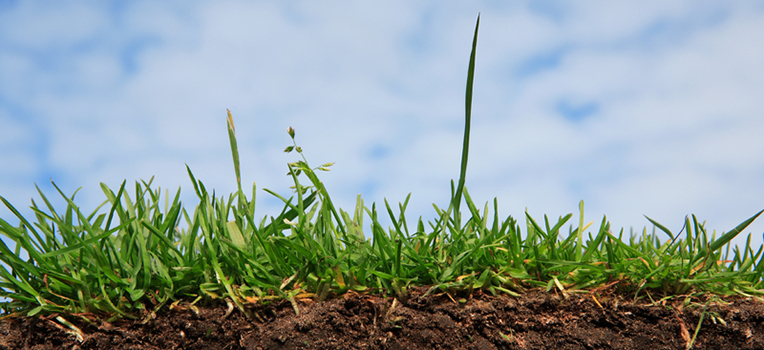Fight Thatch
If you are wondering what thatch is, it’s the layer of partially decomposed stems and roots that builds between your grass and soil surface. Some thatch is beneficial – it conserves ground moisture, cushions turf and insulates soil from extreme temperatures. But anything more than half an inch thick can be problematic. Heavy thatch can repel water, dry up roots and provide cover for unwanted insects.
Control thatch by raking your lawn with a power rake or by using a lawn aerator. A lawn aerator pulls cores out of the soil, allowing water, light and air to enter and gradually break down thatch. Severe cases of thatch may require the use of a mechanical dethatcher, or complete removal and replanting of sod.
Prep Soil
Proper soil preparation can take your lawn from blasé to beautiful. Improving your lawn soil allows roots to grow deeply and more evenly, making your lawn more resistant to drought. To restore valuable nutrients and build soil structure, spread organic material such as compost, peat moss or well-rotted leaf mould evenly on your lawn before seeding. You can also use a specially formulated lawn soil.
Spread Overseed
Overseeding is often overlooked when it comes to home lawn care. Extra seeding can repair bare patches and create a thick lawn that can crowd out weeds, and resist insects and disease. Purchase a grass seed that will grow in both sunny and shady areas, such as Scotts Turf Builder Sun & Shade Grass Seed, and distribute it evenly onto your lawn using a hand-held spreader. If you have a large property, consider investing in a push broadcast spreader. Lightly rake the soil to create seed-soil contact, but don’t cover the grass seed here as it needs direct sunlight to germinate.
Water The Soil
Grass seeds need direct sunlight and regular moisture to germinate, which can take up to three weeks. Be vigilant and water the seed daily, ensuring it stays moist for up to one hour per day. Only once you start to see the grass seed germinate should you begin to cut back on watering. Water new and established lawns early in the morning to avoid any water being lost to evaporation. Also, avoid watering at night — your lawn will likely stay wet all night providing an ideal environment for weeds and disease to take root. Once your lawn is established, water deeply (unless it has rained) with at least one inch of water per week to encourage healthy roots.
Use a “Green” Fertilizer
Your lawn will naturally thrive if you pay attention to it early in the season, but lawns do require fertilizer in order to stay healthy and maintain a lush green appearance. Every eight weeks, use an eco-friendly fertilizer — not only do these products promote strong root development and choke out weeds, they are also safe to use around children and pets, and are permitted in areas with pesticide/herbicide bans. Homemade compost is a natural alternative you can use to provide essential nutrients for a thick, green lawn.
If you have happen to live in the Clayton area we can provide a quote.
We hoped you got some good content from this article about spring lawn care. Please click the Facebook LIKE button below and leave a comment. You can also request a free lawn and garden quote from us today.



 Looking for
Looking for